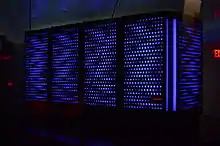Anton (computer)
Anton is a massively parallel supercomputer designed and built by D. E. Shaw Research in New York, first running in 2008. It is a special-purpose system for molecular dynamics (MD) simulations of proteins and other biological macromolecules. An Anton machine consists of a substantial number of application-specific integrated circuits (ASICs), interconnected by a specialized high-speed, three-dimensional torus network.[1]

Unlike earlier special-purpose systems for MD simulations, such as MDGRAPE-3 developed by RIKEN in Japan, Anton runs its computations entirely on specialized ASICs, instead of dividing the computation between specialized ASICs and general-purpose host processors.
Each Anton ASIC contains two computational subsystems. Most of the calculation of electrostatic and van der Waals forces is performed by the high-throughput interaction subsystem (HTIS).[2] This subsystem contains 32 deeply pipelined modules running at 800 MHz arranged much like a systolic array. The remaining calculations, including the bond forces and the fast Fourier transforms (used for long-range electrostatics), are performed by the flexible subsystem. This subsystem contains four general-purpose Tensilica cores (each with cache and scratchpad memory) and eight specialized but programmable SIMD cores called geometry cores. The flexible subsystem runs at 400 MHz.[3]
Anton's network is a 3D torus and thus each chip has 6 inter-node links with a total in+out bandwidth of 607.2 Gbit/s. An inter-node link is composed of two equal one-way links (one traveling in each direction), with each one-way link having 50.6 Gbit/s of bandwidth. Each one-way link is composed of 11 lanes, where a lane is a differential pair of wires signaling at 4.6 Gbit/s. The per-hop latency in Anton's network is 50 ns. Each ASIC is also attached to its own DRAM bank, enabling large simulations.[4]
The performance of a 512-node Anton machine is over 17,000 nanoseconds of simulated time per day for a protein-water system consisting of 23,558 atoms.[5] In comparison, MD codes running on general-purpose parallel computers with hundreds or thousands of processor cores achieve simulation rates of up to a few hundred nanoseconds per day on the same chemical system. The first 512-node Anton machine became operational in October 2008.[6] The multiple petaFLOP,[7] distributed-computing project Folding@home has achieved similar aggregate ensemble simulation timescales, comparable to the total time of a single continuous simulation on Anton, specifically achieving the 1.5-millisecond range in January 2010.[8]
The Anton supercomputer is named after Anton van Leeuwenhoek,[9] who is often referred to as "the father of microscopy" because he built high-precision optical instruments and used them to visualize a wide variety of organisms and cell types for the first time.
The ANTON 2 machine with four 512 nodes and its substantially increased speed and problem size has been described.[10]
The National Institutes of Health have supported an ANTON for the biomedical research community at the Pittsburgh Supercomputing Center, Carnegie Mellon University, and currently (8/20) continues with an ANTON 2 system.
See also
References
- David E. Shaw; Martin M. Deneroff; Ron O. Dror; Jeffrey S. Kuskin; Richard H. Larson; John K. Salmon; Cliff Young; Brannon Batson; Kevin J. Bowers; Jack C. Chao; Michael P. Eastwood; Joseph Gagliardo; J.P. Grossman; C. Richard Ho; Douglas J. Ierardi; István Kolossváry; John L. Klepeis; Timothy Layman; Christine McLeavey; Mark A. Moraes; Rolf Mueller; Edward C. Priest; Yibing Shan; Jochen Spengler; Michael Theobald; Brian Towles; Stanley C. Wang (July 2008). Anton, a special-purpose machine for molecular dynamics simulation. pp. 91–97. doi:10.1145/1364782.1364802. ISBN 978-1-59593-706-3. S2CID 52827083.
{{cite book}}:|journal=ignored (help) (Related paper published in Proceedings of the 34th Annual International Symposium on Computer Architecture (ISCA '07), San Diego, California, June 9–13, 2007). -
Richard H. Larson; John K. Salmon; Ron O. Dror; Martin M. Deneroff; Cliff Young; J.P. Grossman; Yibing Shan; John L. Klepeis; David E. Shaw (2009). High-Throughput Pairwise Point Interactions in Anton, a Specialized Machine for Molecular Dynamics Simulation (PDF). ISBN 978-1-4244-2070-4. Archived from the original (PDF) on June 5, 2011. Retrieved January 13, 2009.
{{cite book}}:|journal=ignored (help) -
Jeffrey S. Kuskin; Cliff Young; J.P. Grossman; Brannon Batson; Martin M. Deneroff; Ron O. Dror; David E. Shaw (2009). Incorporating Flexibility in Anton, a Specialized Machine for Molecular Dynamics Simulation (PDF). ISBN 978-1-4244-2070-4. Archived from the original (PDF) on December 4, 2008. Retrieved January 13, 2009.
{{cite book}}:|journal=ignored (help) - Cliff Young; Ron O. Dror; J. P. Grossman; John K. Salmon; Shaw, David E.; Joseph A. Bank; et al. (2009). "A 32x32x32, spatially distributed 3D FFT in four microseconds on Anton". Proceedings of the Conference on High Performance Computing Networking, Storage and Analysis. New York, NY: ACM. pp. 1–11. doi:10.1145/1654059.1654083. ISBN 978-1-60558-744-8. S2CID 5611246.
- "National Resource for Biomedical Supercomputing". Archived from the original on May 23, 2010. Retrieved May 14, 2010.
- David E. Shaw; Ron O. Dror; John K. Salmon; J.P. Grossman; Kenneth M. Mackenzie; Joseph A. Bank; Cliff Young; Martin M. Deneroff; Brannon Batson; Kevin J. Bowers; Edmond Chow; Michael P. Eastwood; Douglas J. Ierardi; John L. Klepeis; Jeffrey S. Kuskin; Richard H. Larson; Kresten Lindorff-Larsen; Paul Maragakis; Mark A. Moraes; Stefano Piana; Yibing Shan; Brian Towles (2009). Millisecond-Scale Molecular Dynamics Simulations on Anton (PDF). pp. 1–11. doi:10.1145/1654059.1654099. ISBN 978-1-60558-744-8. S2CID 4390504. Archived from the original (Portland, Oregon) on April 23, 2012. Retrieved April 20, 2012.
{{cite book}}:|journal=ignored (help) - Pande Group (March 2017). "Client Statistics by OS". Stanford University. Retrieved February 3, 2012.
- Vijay Pande (January 17, 2010). "Folding@home: Paper #72: Major new result for Folding@home: Simulation of the millisecond timescale". Retrieved September 22, 2011.
- John Markoff (July 8, 2008). "Herculean Device for Molecular Mysteries". The New York Times. Retrieved April 25, 2010.
- Shaw, David E; Grossman, JP; Bank, Joseph; A Batson, Brannon; Butts, J Adam; Chao, Jack C; Deneroff, Martin M; Dror, Ron O; Even, Amos (2014). "Anton 2: Raising the Bar for Performance and Programmability in a Special-Purpose Molecular Dynamics Supercomputer". SC14: International Conference for High Performance Computing, Networking, Storage and Analysis. New Orleans, LA: ACM. pp. 41–53. doi:10.1109/SC.2014.9. ISBN 978-1-4799-5499-5. S2CID 3354876.